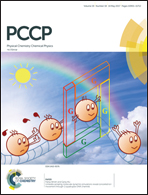Excited state relaxation processes of H2-evolving Ru–Pd supramolecular photocatalysts containing a linear or non-linear bridge: a DFT and TDDFT study†
Abstract
In this study, the early-time excited state relaxation processes of bimetallic Ru–Pd supramolecular photocatalysts containing a linear 2,2′:5′,2′′-terpyridine or a nonlinear 2,2′:6′,2′′-terpyridine bridging ligand (BL) were investigated by density functional theory (DFT) and time-dependent DFT (TDDFT) approaches. The bridge based metal-to-ligand charge transfer triplet (3MLCT) state of the metal complex containing a linear bridging ligand was calculated to be the lowest energy triplet (T1) state which is closely related to the photocatalytic H2 production, while for that having a nonlinear bridging ligand, the T1 state is a Ru metal-centered (MC) triplet (3MCRu) state that is short-lived and rapidly decays to the ground electronic state (S0). Our simulation provides an alternative explanation for the smaller interligand electron transfer (ILET) rate in the Ru–Pd complex containing a linear bridge compared to the corresponding monometal Ru complex. Based on the calculation, we also suggest that the successive 3MLCT → 3MCRu → S0 conversion is responsible for the inefficiency of the Ru–Pd complex containing nonlinear bridge as a photocatalyst for H2 production. This study provides theoretical insights into the key steps of the photoinduced processes of the bimetallic H2-evolving supramolecular photocatalyst.



 Please wait while we load your content...
Please wait while we load your content...